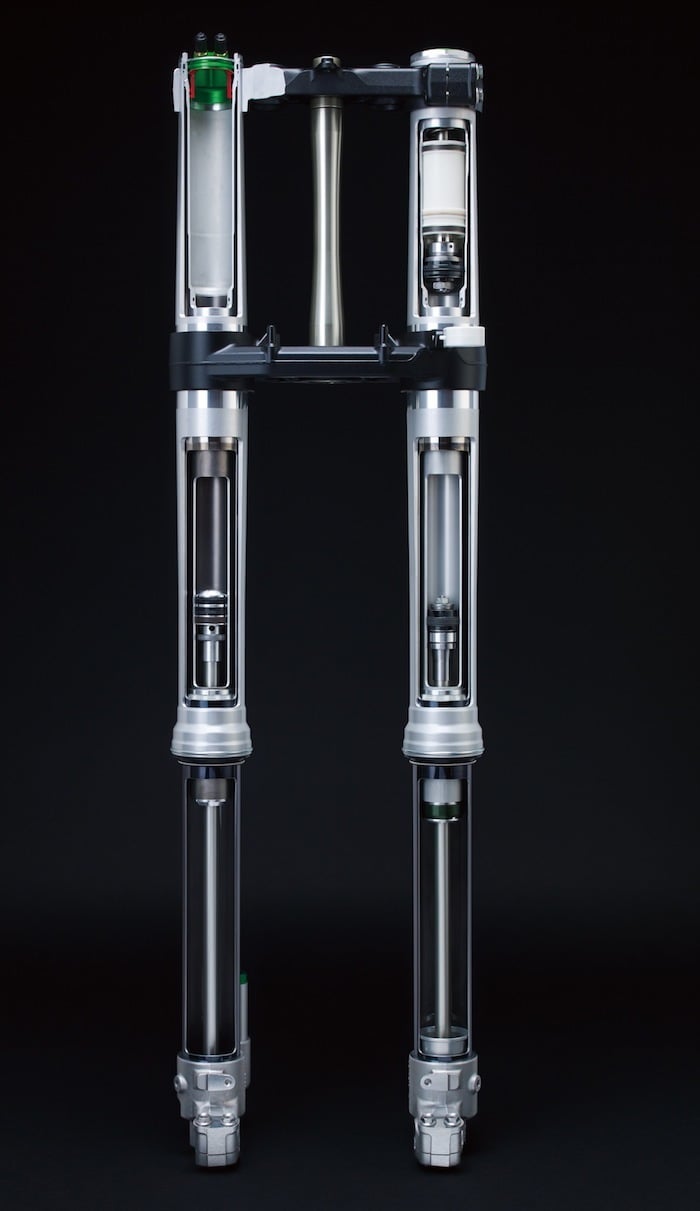ASK THE MXPERTS: FIX MY 2015 KX450F FORKS FOR ME

Dear MXA,
I bought a new Kawasaki KX450F and can’t get the Showa TAC forks to work as well as the old spring fork on my 2011 KX450F. I need help. I asked a local Pro what settings he was running in his TAC forks and put them in my fork. That was a disaster, because I only got 2 inches of travel with his numbers. Can you fix my KX450F forks for me?
Yes‚ no‚ maybe? The Showa SFF-TAC Air forks are the most complicated, complex and difficult-to-tune forks ever put on a production bike. They should never have been spec’ed on a bike going out to the general public. With three different air pressures, 20 different compression and rebound settings and four different oil height adjustments, a rider has 420,000 tuning combinations to work with. And this in a sport where a large percentage of riders never touch the clickers on their suspension or check the air pressure in their tires. But, it’s too late to moan about the overly complex Triple Air Chamber (TAC) forks because they are here, so we have to make the best of a difficult situation.
The best way to understand how Showa TAC forks work is to think of them like submarine. Like a submarine, the TAC fork has three different air chambers.
(1) Inner chamber: The inner chamber, which would be where the sub crew lives and works, is the most important part of the sub (and TAC fork). The Showa’s inner chamber works as the main fork spring.
(2) Outer chamber: The outer chamber surrounds the inner chamber. It is the fail-safe system both on a submarine and a Showa SFF-Air fork. It protects the inner chamber of the submarine from terminal damage. On the Showa TAC fork, it works as a low-pressure chamber that allows a fork seal to blow without leaking air pressure from the high-pressure inner chamber.
(3) Balance chamber: A submarine has balance chambers that allow the submarine to surface or submerge based on the pressure inside these tanks. On the Showa TAC air fork, the balance chamber, located in the piggyback reservoir on the lower right fork leg, provides air pressure that works in the opposite direction of the other two chambers. While the inner and outer chambers both push the fork downward towards the ground, the balance chamber pushes the fork upward.

Changing the air pressure in the balance chamber has several effects on the forks’ performance. First, if you increase the pressure in the balance chamber, the fork’s overall length will decrease. If you lower the pressure in the balance chamber, the fork will get longer. Additionally, raising the air pressure in the balance chamber will make the fork feel softer in its initial stroke, while lowering the balance chamber pressure will make it feel stiffer. In this situation, the balance chamber works very much like preload on an old-school, coil-spring fork. Finally, the air pressure in the balance chamber stops the TAC fork from topping out when the front wheel is off the ground‚ which was a common problem on previous air forks.
To adjust your 2015 Kawasaki TAC Air forks, you need to set the air pressure in all three chambers. The inner chamber is the actual fork spring and has an air pressure range from 87 psi to 187 psi (145 psi is stock). Increasing the air pressure in the inner chamber stiffens the spring rate, while reducing it lowers it. The outer chamber is kind of a booster air pressure reserve. The stock air pressure in the outer chamber is 7.3 psi, but most fork pumps aren’t accurate to that small a number. MXA uses the outer chamber as a bottoming device by running anywhere from 0 psi to 20 psi to kick in a last burst of spring rate late in the stroke. The balance chamber can be set as low as 76 psi to as high as 203 psi (131 psi is stock). Since the inner chamber and balance chamber are diametrically opposed to each other in a pressure war, the ratio between the two chambers is almost as important as the amount of air pressure.
But what you want to know is how much air to put in each chamber to make your forks work up to snuff. Sadly, the numbers vary with the speed of the rider, size of the jumps and roughness of the track. And, during testing, we were able to get fairly different air pressures to work almost the same way by juggling their relationship to each other. However, we think that most Kawasaki KX450F owners just want someone to give them the three air pressures that will work for them. We wish that was possible, but we aren’t you, we don’t ride as fast as you and we aren’t at your local track. However, we will give you a ballpark starting spot.
MXA settled on its air pressures by starting with the overly soft stock Kawasaki numbers and working our way up the pressure scale. In the end, we didn’t use a single recommended Kawasaki air pressure setting. Our numbers work for a wide variety of riders, but they don’t take into account your personal peccadilloes. It is equally important to note that the air pressure is just the spring; it is not the damping. The compression and rebound clickers are as important as they ever were‚ so try not to focus so much on air pressure that you ignore the damping.
For hardcore racing, we ran this setup on the 2015 Kawasaki KX450F (stock specs are in parentheses). Start with these numbers and make adjustments in 5 psi increments.
Inner spring rate: 160 psi (145 psi)
Outer spring rate: 10 psi (7.5 psi)
Balance spring rate: 170 psi (135 psi)






Comments are closed.